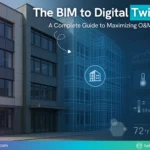A Guide on OpenBIM for the AEC Industry
July 25, 2023

Building Information Modeling (BIM) has emerged as a powerful tool in today’s rapidly evolving construction industry. It enables architects, engineers, contractors, and other stakeholders to collaborate seamlessly, enhancing coordination, communication, and efficiency. However, one approach that has gained significant traction and adoption recently is OpenBIM. BIM and OpenBIM are revolutionizing how buildings are designed, constructed, and maintained, improving project outcomes, and increasing sustainability. This blog post explores all about OpenBIM, its top five benefits of OpenBIM and its crucial role in revolutionizing the construction industry.
An Overview of OpenBIM
OpenBIM is a philosophy and approach that promotes interoperability and open standards in BIM workflows. It emphasizes using open file formats and software solutions that facilitate collaboration and data exchange among different disciplines and software platforms, fostering an inclusive and collaborative environment for the entire construction industry.
OpenBIM, introduced by buildingSmart International, aims to establish a common language for effective communication among diverse BIM software systems in the construction industry. BuildingSMART collaborates with various stakeholders, such as technology providers, owners, contractors, and designers, to achieve this. The organization’s Strategic Advisory Council plays a crucial role in developing and promoting open, neutral standards for data interoperability and setting quality benchmarks.
At the core of OpenBIM lies a standardized communication protocol based on Industry Foundation Classes (IFC), overseen by the International Standards Organization (ISO). This standardized framework enables seamless import and export of data between different technologies. Consequently, organizations can freely choose their preferred tools without being restricted by proprietary data formats.
Benefits of OpenBIM for the Construction
OpenBIM is of utmost importance to the construction industry as it provides a standardized and open framework for data interoperability among diverse BIM software systems. By establishing a common language based on Industry Foundation Classes (IFC), OpenBIM enables seamless communication and exchange of information between different technologies and stakeholders throughout the construction lifecycle. This eliminates the limitations of proprietary data formats and encourages collaboration, innovation, and flexibility in technology adoption.
Many industry leaders state that OpenBIM fills a critical gap in realizing the promise of BIM for the construction industry. Let’s look at some of the top benefits of OpenBIM that are revolutionizing the AEC industry.
-
Enhanced Collaboration & Communication
OpenBIM enables a seamless exchange of information among project participants, regardless of the software platforms they use. Adopting open standards such as Industry Foundation Classes (IFC) makes the data generated and shared within the BIM environment universally accessible. This fosters effective collaboration between architects, engineers, contractors, and other stakeholders, promoting interdisciplinary coordination and reducing conflicts.
With OpenBIM, project teams can work concurrently, avoiding errors and reducing rework by resolving clashes and design conflicts early in the process. The enhanced collaboration and communication fostered by OpenBIM lead to better-informed decision-making and improved project outcomes.
-
Increased Efficiency & Productivity
OpenBIM streamlines project workflows by integrating various software applications and tools into a unified digital environment. This integration allows for efficient data sharing, real-time updates, and automated processes. It facilitates clash detection, quantity take-offs, scheduling, and cost estimation, eliminating the need for manual and time-consuming coordination between different software systems. Moreover, the ability to reuse BIM data throughout the project lifecycle saves time and effort.
With OpenBIM, stakeholders can work more efficiently, increasing productivity and faster project delivery.
-
Cost Savings & Risk Reduction
OpenBIM helps identify and mitigate potential design and construction issues early in the project lifecycle, thus reducing risks and associated costs. By allowing for accurate clash detection, resolution, and prevention, it minimizes conflicts and rework, saving time and resources. The integrated nature of OpenBIM ensures that changes made in one aspect of the model automatically propagate throughout the project, minimizing the chances of inconsistencies and errors.
Additionally, it facilitates accurate quantity take-offs and cost estimation, enabling better budget control and cost optimization—identifying and addressing issues proactively with OpenBIM results in significant cost savings and risk reduction.
-
Improved Design and Construction Quality
OpenBIM promotes a holistic approach to design and construction, fostering improved quality throughout the project lifecycle. The stakeholders have access to a comprehensive digital representation of the building, allowing for better visualization and analysis of design alternatives. This enables early identification of constructability issues, spatial conflicts, and performance discrepancies, facilitating better design decisions.
It also supports integrating sustainability analysis, energy modeling, and other performance simulations, enabling optimized design solutions. By facilitating enhanced design coordination, OpenBIM helps ensure that the final built environment aligns with the project’s objectives, resulting in improved design and construction quality.
-
Increased Sustainability & Energy Efficiency
OpenBIM is crucial in promoting sustainability and energy efficiency in the construction industry. By incorporating energy modeling and analysis within the BIM environment, stakeholders can evaluate the environmental performance of a building throughout its lifecycle. It enables the integration of various sustainability metrics, such as energy consumption, daylighting, thermal performance, and material lifecycle assessment. This allows designers to make informed decisions about sustainable building systems, materials, and construction techniques.
Accurate energy modeling helps optimize building performance, reduce energy consumption, and minimize a project’s carbon footprint. By leveraging OpenBIM’s capabilities, the AEC industry can contribute to a more sustainable and environmentally conscious built environment.
Conclusion
OpenBIM is transforming the AEC industry by promoting enhanced collaboration and communication, increasing efficiency and productivity, saving costs and reducing risks, improving design and construction quality, and driving sustainability and energy efficiency. With its focus on interoperability and open standards, OpenBIM has the potential to transform the way construction projects are planned, executed, and managed. Embracing OpenBIM enables stakeholders to work together seamlessly, exchange data effortlessly, and make informed decisions throughout the project lifecycle.
However, the adoption of OpenBIM requires an effort from multiple players worldwide. The buildingSMART International rightly says, “OpenBIM requires commitment from the industry. This includes developing and supporting open and neutral standards, high-quality implementation of the standards, and approved independent benchmarks to ensure quality and rigor.“
Let’s harness the power of OpenBIM to unlock new levels of innovation, efficiency, and client satisfaction in the construction industry.















